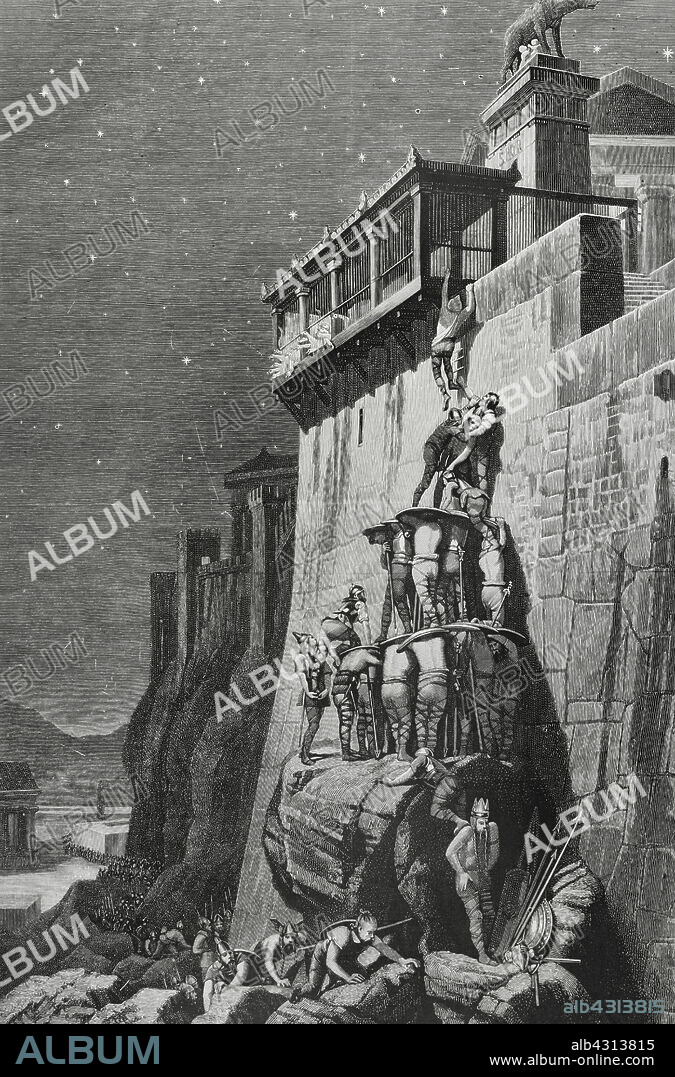alb4313815
C. ROBERTS. 19TH-CENTURY WOOD ENGRAVER.. Ancient Rome, 4th century BC. After the sack of Rome by the Gauls, the survivors of the city took refuge in the Capitol, raised on one of the city's hills and also where the temple of Juno was located. Inside the temple lived the sacred geese, used for sacrifices in honour of the goddess Juno. One night, the Gauls tried to attack the Romans who had taken refuge there. They climbed the hill, taking advantage of the silence of the night. The Roman guards and the dogs had fallen asleep, but the Gauls raiders encountered the geese, which became frightened and made a great fuss, waking the Romans. They were able to respond and repel the attack. However, the resistance to the Gauls' siege was prolonged and the Romans decided to pay a ransom to the Gauls in exchange for their leaving the city. Assault on the Roman Capitol by the Gauls. Engraving by C. Roberts based on a painting by Henri-Paul Motte (1846-1922). La Ilustración Española y Americana (The Spanish and American Illustration), February 29, 1884.

|
Ajouter à une autre Lightbox |
|
Ajouter à une autre Lightbox |



Avez-vous déjà un compte? S'identifier
Vous n'avez pas de compte ? S'inscrire
Acheter cette image

Légende:
Voir la traduction automatique
Ancient Rome, 4th century BC. After the sack of Rome by the Gauls, the survivors of the city took refuge in the Capitol, raised on one of the city's hills and also where the temple of Juno was located. Inside the temple lived the sacred geese, used for sacrifices in honour of the goddess Juno. One night, the Gauls tried to attack the Romans who had taken refuge there. They climbed the hill, taking advantage of the silence of the night. The Roman guards and the dogs had fallen asleep, but the Gauls raiders encountered the geese, which became frightened and made a great fuss, waking the Romans. They were able to respond and repel the attack. However, the resistance to the Gauls' siege was prolonged and the Romans decided to pay a ransom to the Gauls in exchange for their leaving the city. Assault on the Roman Capitol by the Gauls. Engraving by C. Roberts based on a painting by Henri-Paul Motte (1846-1922). La Ilustración Española y Americana (The Spanish and American Illustration), February 29, 1884.
Emplacement:
Collection privée
Crédit:
Album / Prisma
Autorisations:
Modèle: Non - Propriété: Non
Questions sur les droits?
Questions sur les droits?
Taille de l'image:
3425 x 5199 px | 50.9 MB
Taille d'impression:
29.0 x 44.0 cm | 11.4 x 17.3 in (300 dpi)
Mots clés:
4E SIECLE AV. JC • 4EME S AV NE • AGILITÉ • ANTIQUITE • ANTIQUITÉS • ART GAULOIS • ART ROMAIN • ART, PEINTURE • ASSAULT • ASSAUT • ASSOUPI • ASSOUPISSEMENT • ATTAQUE • ATTAQUES • BARBARE • BARBARES • BRUIT FORT • BRUIT • C. ROBERTS. 19TH-CENTURY WOOD ENGRAVER. • CADRE • CALME • CANIN • CHIEN • CIEL NUIT • COLLECTION PRIVÉE • DOMINATION • DORMIR • ÉMEUTE • EMPIRE ROMAIN D'OCCIDENT • EMPIRE ROMAIN • ENDORMI • EPOQUE ROMAINE • ESCALADER • ESCALDE • EUROPE • EUROPÉEN • FORCE • FORTIFICATION: REMPARTS • FRAVURE • GAULE ET GAULOIS • GAULES • GAULOIS • GRAVIR • GRAVURE • GRIMPANTE • GRIMPER • GUERRE SIEGE • GUERRIER • HISOIRE • HISTOIRE • IMAGES • INTERIEUR: TABLEAUX • INVASION MILITAIRE • INVASION • LEGENDE • LÉGENDES • MUR D'ENCEINTE • MUR • MURAILLE • MUTITE • MYTHES • MYTHOLOGIE • NUIT • OFFENSIVE • OIE • OIES • PEINDRE • PEINTURE • PEINTURE, SCENES D'INTERIE • PERIODE: ROME IMPERIALE • POUVOIR • PUISSANCE MUSCULAIRE • RECKE • REMPARTS • ROMAIN • ROME • ROME, IMPERIALE • S'ENDORMIR • SAC DE ROME • SENON • SIEGE (GUERRE) • SIEGE (MILITAIRE) • SIEGE • SILENCE • SOMMEIL • SOUVERAINETE • STRATEGIE • SUPREMATIE • TABLEAU • TABLEAU: SCENES D'INTERIEU • TABLEAUX • TEMPS NUIT • TRANQUILLITE • VACARME • VIRILITE, FORCE
 Pinterest
Pinterest Twitter
Twitter Facebook
Facebook Copier le lien
Copier le lien Email
Email
